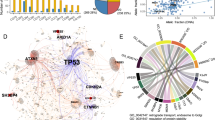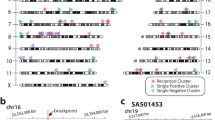Abstract
Hepatocellular carcinoma, one of the most common virus-associated cancers, is the third most frequent cause of cancer-related death worldwide1. By massively parallel sequencing2 of a primary hepatitis C virus–positive hepatocellular carcinoma (36× coverage) and matched lymphocytes (>28× coverage) from the same individual, we identified more than 11,000 somatic substitutions of the tumor genome that showed predominance of T>C/A>G transition and a decrease of the T>C substitution on the transcribed strand, suggesting preferential DNA repair. Gene annotation enrichment analysis3 of 63 validated non-synonymous substitutions revealed enrichment of phosphoproteins. We further validated 22 chromosomal rearrangements, generating four fusion transcripts that had altered transcriptional regulation (BCORL1-ELF4) or promoter activity. Whole-exome sequencing4,5 at a higher sequence depth (>76× coverage) revealed a TSC1 nonsense substitution in a subpopulation of the tumor cells. This first high-resolution characterization of a virus-associated cancer genome identified previously uncharacterized mutation patterns, intra-chromosomal rearrangements and fusion genes, as well as genetic heterogeneity within the tumor.
This is a preview of subscription content, access via your institution
Access options
Subscribe to this journal
Receive 12 print issues and online access
$209.00 per year
only $17.42 per issue
Buy this article
- Purchase on Springer Link
- Instant access to full article PDF
Prices may be subject to local taxes which are calculated during checkout



Similar content being viewed by others
References
El-Serag, H.B. & Rudolph, K.L. Hepatocellular carcinoma: epidemiology and molecular carcinogenesis. Gastroenterology 132, 2557–2576 (2007).
Bentley, D.R. et al. Accurate whole human genome sequencing using reversible terminator chemistry. Nature 456, 53–59 (2008).
Huang, W., Sherman, B.T. & Lempicki, R.A. Systematic and integrative analysis of large gene lists using DAVID Bioinformatics Resources. Nat. Protoc. 4, 44–57 (2009).
Ng, S.B. et al. Targeted capture and massively parallel sequencing of 12 human exomes. Nature 461, 272–276 (2009).
Gnirke, A. et al. Solution hybrid selection with ultra-long oligonucleotides for massively parallel targeted sequencing. Nat. Biotechnol. 27, 182–189 (2009).
Pleasance, E.D. et al. A comprehensive catalogue of somatic mutations from a human cancer genome. Nature 463, 191– (2010).
Xiang, Z. et al. Identification of somatic JAK1 mutations in patients with acute myeloid leukemia. Blood 111, 4809–4812 (2008).
Pagan, J.K. et al. A novel corepressor, BCoR-L1, represses transcription through an interaction with CtBP. J. Biol. Chem. 282, 15248–15257 (2002).
Miyazaki, Y., Sun, X., Uchida, H., Zhang, J. & Nimer, S. MEF, a novel transcription factor with an Elf-1 like DNA binding domain but distinct transcriptional activating properties. Oncogene 13, 1721–1729 (1996).
Suico, M.A. et al. Functional dissection of the ETS transcription factor MEF. Biochim. Biophys. Acta 1577, 113–120 (2002).
Mardis, E.R. et al. Recurring mutations found by sequencing an acute myeloid leukemia genome. N. Engl. J. Med. 361, 1058–1066 (2009).
Ding, L. et al. Genome remodelling in a basal-like breast cancer metastasis and xenograft. Nature 464, 999–1005 (2010).
Shah, S.P. et al. Mutation evolution in a lobular breast tumour profiled at single nucleotide resolution. Nature 461, 809–813 (2009).
Parsons, D.W. et al. An integrated genomic analysis of human glioblastoma multiforme. Science 321, 1807–1812 (2008).
Jones, S. et al. Core signaling pathways in human pancreatic cancers revealed by global genomic analyses. Science 321, 1801–1806 (2008).
Wood, L.D. et al. The genomic landscapes of human breast and colorectal cancers. Science 318, 1108–1113 (2007).
Pleasance, E.D. et al. A small-cell lung cancer genome with complex signatures of tobacco exposure. Nature 463, 184–190 (2010).
Lee, W. et al. The mutation spectrum revealed by paired genome sequences from a lung cancer patient. Nature 465, 473–477 (2010).
Greenman, C. et al. Patterns of somatic mutation in human cancer genomes. Nature 446, 153–158 (2007).
Machida, K. et al. Hepatitis C virus induces a mutator phenotype: enhanced mutations of immunoglobulin and protooncogenes. Proc. Natl. Acad. Sci. USA 101, 4262–4267 (2004).
Kim, M.Y. et al. Tumor self-seeding by circulating cancer cells. Cell 139, 1315–1326 (2009).
Guertin, D.A. & Sabatini, D.M. Defining the role of mTOR in cancer. Cancer Cell 12, 9–22 (2007).
Yilmaz, O.H. et al. Pten dependence distinguishes haematopoietic stem cells from leukaemia-initiating cells. Nature 441, 475–482 (2006).
Meric-Bernstam, F. & Gonzalez-Angulo, A.M. Targeting the mTOR signaling network for cancer therapy. J. Clin. Oncol. 27, 2278–2287 (2009).
Li, H. & Durbin, R. Fast and accurate short read alignment with Burrows-Wheeler Transform. Bioinformatics 25, 1754–1760 (2009).
Li, H. et al. The Sequence alignment/map (SAM) format and SAMtools. Bioinformatics 25, 2078–2079 (2009).
Acknowledgements
We thank K.K. Khanna (The Queensland Institute of Medical Research) for providing a human BCORL1 cDNA clone; T.D. Taylor (RIKEN) for comments on the manuscript; T. Urushidate, S. Ohashi, S. Ohnami, A. Kokubu, N. Okada, K. Shiina, H. Meguro and K. Nakano for their excellent technical assistance. This work was supported by the Program for Promotion of Fundamental Studies in Health Sciences of the National Institute of Biomedical Innovation (NIBIO), Japan, and the Industrial Technology Research Grant Program from the New Energy and Industrial Technology Development Organization (NEDO), Japan. This study is associated with the International Cancer Genome Consortium (ICGC), and the mutation data were deposited at and released from the ICGC web site.
Author information
Authors and Affiliations
Contributions
The study was designed by T. Shibata, H.A., T.Y. and J.K. Sequencing and data analyses were conducted by Y.T., K.T., S.Y., S.T., K. Sonoda and H.T. Allele typing and copy number analyses were performed by H.S. and S.I. Other molecular studies were done by Y.A., F.H., T. Shirakihara, and L.W.; H.O., K. Shimada, T.K., T.O. and K.K. coordinated collection of clinical sample and information. The manuscript was written by Y.T., T. Shibata, K.T., S.Y., H.A. and T.Y.
Corresponding author
Ethics declarations
Competing interests
The authors declare no competing financial interests.
Supplementary information
Supplementary Text and Figures
Supplementary Note, Supplementary Figures 1–13 and Supplementary Tables 1–9. (PDF 4987 kb)
Rights and permissions
About this article
Cite this article
Totoki, Y., Tatsuno, K., Yamamoto, S. et al. High-resolution characterization of a hepatocellular carcinoma genome. Nat Genet 43, 464–469 (2011). https://doi.org/10.1038/ng.804
Received:
Accepted:
Published:
Issue Date:
DOI: https://doi.org/10.1038/ng.804



